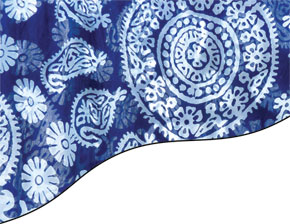 Pages 40-43
Pages 40-43by Fiona Maclachlan
Silk. Even the word conjures up exotic images of luxury and mysticism. The Silk Road adds to all this the added dimension of the long-ago plod of camel caravans, Arabian nights storytelling and, of course, trade across the world’s great empires. This historical route carried merchandise between east and west much of the way around the world and influenced much of the development of the world we know today. Some of the goods conveyed found new homes and in time their origins became forgotten or ignored, or didn´t seem important anymore.
Azerbaijan lies on the branch heading north from what is currently southern Iran. Although it was a major hub in days gone by, it was effectively bypassed during more recent history, particularly during Soviet times. As it emerges from Soviet rule, it is reaffirming its place in the world, re-acknowledging its own history, and looking to market what it does best. In keeping with its ancient traditions as a hub, it looks east and west, north and south. Indeed Azerbaijan is establishing business and trade links with many countries.
Fortunately, there are many opportunities, based on the country’s historical strengths. Azerbaijan is developing them and has quality goods to sell to a world which sometimes feels rather full of inferior junk. Time then to go and find out how this is happening.
On the road
With the hope of an adventure or two (travel in Azerbaijan is seldom uneventful), a couple of us of head west from Baku for the foot hills of the Caucasus mountains, pretty much along an old Silk Route.
I am travelling with travel writer Mark Elliott and although I know Azerbaijan very well, I am still in awe of Mark´s well-published and well-read expertise, so I look forward to gaining an insight into his way of travelling.
One aim is to discover some of the old grape varieties of the region. Do you know that Azerbaijan has hundreds of types of grape? In Soviet times, it was a significant producer of wine which was largely exported to Russia. But in the 1980s, the vineyards were no longer in use and were lost or destroyed.
Heading west from Baku, across the desert towards Shamakha, we drive past the village of Medresa, home of the Medresa grape, promising to ourselves to stop on the way home, and we go first to Shato Monolit, the unlikely sounding name of a new winery situated some 15km beyond Ivanovka, the Russian collective farm near Ismayilli. The French copied the vine growing and wine making from this region, made a success of it and then, many years later, this region copies the French names, but spells them with a local touch. With summers that are generally hotter and longer than in much of France, the grapes have high sugar content and I find the wines in Azerbaijan are generally sweeter and more flavoursome than their French counterparts. The fact that the local people here do have a sweet tooth, as indicated by the recent Marco Polo slow food study, is all the more interesting. (medialab.sissa.it/marcopolo/eng2010.html) Not all expats develop a taste for sweet Azerbaijani wines, but luckily for me it came almost naturally and I find it a pleasant drink, especially the reds from the very region we were heading for - Ismayilli and Ivanovka.
Shato?
Mark´s aim is to see the new face of Azerbaijan´s wine making. We arrive at Shato Monolit to find it apparently closed and unwelcoming - the big gates across the drive are firmly shut. But they aren´t locked and so we open them ourselves and go in, a little nervously. There’s no one to be seen and the complex feels closed. After knocking on the door of the massive barrel shaped entrance of the main building we are welcomed in, yes, just a little as if we are arriving at some chateau, with just a touch of the atmosphere of the Rocky Horror film. The welcome, once inside, is perfectly genuine thank goodness! We were simply unexpected.
Mark told you about the winery in the last (July-August) edition and I, too, would urge you to visit ´les caves´ which, although new, are truly atmospheric and worthy of the dungeon of any chateau, rocky, horror or otherwise.
He didn’t mention one richer red, which seemed familiar but I couldn´t place at the time. We said, initially, ´can´t drink this´, then tried again, said ´like port´, we said ´with cheese´. But now I remember. It is like Banyuls. I want to go back and try it again.
There follows a very late lunch in Ivanovka, in the kafe seemingly simply called ´kafe´, overlooking the lake, where the previously ‘tasted’ wine is belatedly mopped up by kebabs.
Silkwards
Of course an advantage of travelling with Mark Elliott is that he knows about everything and when he mentions that we can visit the silk factory in Basqal, a small village just off the main road between Ismayilli and Shamakha, I decide that Medresa can wait for another day.
I have a rug in my hallway in the UK that comes from Basqal and although it´s not silk, I like the sound of a visit to a silk factory there.
And anyway it brings us back to my original theme of silk.
Who doesn´t love silk, either its smooth fine finish or less refined in its coarser form? It´s an amazing fabric, comfortable both when in the cool and the heat. Luxury and practicality in one textile.
To reach Basqal from the main Shamaxa - Ismayilli road is easy. Take the road up to Basqal (a turning to your right as you come from Shamakha) - you can´t miss the colourful (Azerbaijan-flag- style colourful) entrance sign. As you approach the village, the purple/red and orange painted building on the right hand side is the silk factory. If you reach the bridge then you´ve gone too far, retrace your route and it´s on the left. The recently painted metal entrance door is a bright pinky-purple and has white posters on the door indicating that Japan has sponsored the factory. Yellow signs to either side of the door say Basqal Silk Centre ‘Kelagayi’.
In this factory they typically produce kelegayi. These are traditional scarves worn by women in Azerbaijan; which is the only place they are made and they are regarded as a masterpiece of ethnic art. A hot batik technique is used to print the scarf and the colours are then added in stages.
The Kelegayi…
are usually decorated with floral or geometric designs and painted in various colours, the more colours the more prized the kelegayi. The designs along the edge are known as yelani (border) and the designs in the middle are called khoncha (panel).
By tradition, young girls use the kelegayi as orpek, and older women as chalma or dinge. Always they are wrapped around the head. Orpek means that the scarf is wrapped around the head and tied loosely under the chin. Chalma means that the scarf is worn wrapped around the head and is tied behind the head at the base of the neck. Dinge means that the scarf is wrapped around the head, crossed at the back like the chalma with the ends brought back around and tied atop the forehead. Nowadays of course they are used as shawls or to wear as you like, though many prefer the traditional ways. Azerbaijani girls I spoke to seemed to think it would not be right for me to use one to decorate the top of a special piece of furniture, to hang on a wall or to leave casually over the bedroom chair as if you might put it on every day. But they are too pretty to put in a drawer for occasional use!
The factory doesn’t appear open or inviting but we notice that the door, though firmly shut, isn´t actually locked. We try knocking with no response and finally I try a loud rat-a-tat-tat and Open sesame! and as if by magic the door flies open and we go inside.
Unexpected, but welcomed yet again. (I begin to think about how much goes on behind closed doors, and how all it would take is the right sort of knock on the door..)
Out of darkness…
The darkness of the first room leads us to another, brighter room, a workshop, where all the activity seems to happen. Various old wooden barrels are full of dark liquids and some steep-sided baths are full of murky looking water.
A few men, dressed in vests and galoshes, are plunging silk kelegayis in and out of the baths as they rinse them prior to hanging them out to dry. Their hard worked hands are coloured by the dyes.
…comes the light
And out beyond is the drying area where, Wow! just look at the simply beautiful colours of the kelegayis hanging over washing lines, drying in the bright morning sunshine. I rush over to look at their vibrant colours, touch the fabric and I feel a definite urge to have one, but which? Against the backdrop of trees and mountains, they all look so beautiful.
I go back into the darker interior where the men are washing and rinsing. I want to watch, I want to see the dyes, and I want to see how the designs are put on to the scarves. Mark, meantime, heads for the museum at the far end of the drying green.
I’m standing on the wet, slippery concrete floor and start to ask questions. The factory has been working since 2003. There was an earlier factory, opposite the present one, but it closed in 1997. There are a couple of big machines in there, too large for current use.
This isn´t actually a factory here making silk, that´s done in Sheki, further west along the silk road route, which follows the foot of the Caucasus Mountains. Sheki is the main silk centre in Azerbaijan.
Looking for JT
Basqal’s factory is working thanks to a lady called Rena Ibragimbeyova, a niece of one of the workers. Her husband Jalil Tariverdiyev is the factory owner. The workers explain that she is interested in developing knowledge in this sphere and that they applied for, and won, financial support from Japan. Rena actively promotes the products; she was, for example a guest speaker at the Ankara Women’s International Club earlier this year.
The factory typically employs ten or sometimes up to seventeen people, depending on the size of the current order. Everything is made to order, usually for special events, for example for the International Jazz Festival. In a typical month they might make 500-800 kelegayis, or similar items. Hopes are high for big orders for Eurovision.
So how is it possible to tell that a kelegayi comes from this factory in Basqal, I ask? You can see the initials ‘JT’ on the designs, and they show me. These are the factory owner’s initials.
We are just seeing a snapshot of the process, so I ask how it all begins.
How it’s done
First of all the white silk from Sheki is boiled for half an hour and allowed to dry. The next stage is to stamp on the design. In the first room there is a selection of wooden stamps which are used to create the design. Some of these are very old and as I photograph them I wonder how many times they have been used. A small burner melts the wax which is then applied to the fabric using the chosen stamp, to create the desired design.
Next some colour is painted onto the fabric. We didn’t see this part of the process but I think it would be the most interesting. Qadir Shafiyev, the painter, explains that traditionally only three, or sometimes four, colours were used but that these days up to fifteen colours can be applied. Although born in Basqal, Qadir learnt the skill in Georgia when he was only 12 years old. He lived in Georgia between 1942 and 1958. He is proud to have passed on his skills to others, over the years, and has worked in various regions of Azerbaijan. But for now Qadir does the most important part of the work in Basqal, making the colours and doing the painting. This is the skilful part, he says. (How will they manage one day without me?) And he’s proud that the kelegayi are sent all over the world.
The colours, the dyes, are in liquid form in various big containers in the workshop. The depth of colour, with an almost hidden brightness, is entrancing, especially when the liquid is poured in the subdued daylight of the workshop. Against one wall there is a pile of sticks/wood; this they say is the Narinj tree from which they make the colour yellow.
The fabric is then pressed between two planks of wood with screws at each end, forming a press, rather like a flower press.
Next, the fabric is washed in hot water containing soda, the soda fixing the dye, and the warm water removes the wax which floats to the top, settles, and sets as the water cools. The wax is later removed and can be re-used.
The fabric is allowed to dry in the sun and the process of painting and dying is repeated until more colours are added as required for the finished design.
All waste water gets thrown down the drain at the end of the workshop, as happens with all the waste water from washing.
There must be a considerable amount of dye going down the drain but this seemed of no concern. Basqal has been using dyes like this for centuries, and the village drainage system is of medieval origin, apparently predating the one in nearby Lahij which is well known to tourists.
Ancient rivalry….
The Basqal silk workers do not believe the one in Lahij to be original, saying there was no reason to have such a system there. In an attempt to further discredit their neighbour (which currently receives much international support although it is one of many ancient villages in the region), these Basqal residents claim that Lahij people even stole old gravestones from there to improve their own village’s history. This all came about because Lahij people wanted to stay in Basqal when they arrived in the 5th century, but the locals said no. The stories told of Basqal are of an ancient village which made much money from silk and silk goods. In fact it got so rich that at one time all the work was actually done by villagers from small surrounding villages...
Goodness, what long memories! Whatever, the history of Basqal needs a closer look and I would like to explore this village further. (This wonderful article, describing the history of Basqal gives a taste of what I might find: sayt.ws/mauqli/index.php?cstart=3&newsid=53720)
The small museum at the end of the drying green contains examples of colourful old Azerbaijani silks, explains the silk making process, exhibits some old stamps, some of which have been used to transfer the hot wax for various special events (as well as some precious, even more ancient stamps). Some examples of special orders are on display and it is obvious that the factory produces high quality items for some of Azerbaijan’s most prestigious events.
Displays in the garden show the silk route, the silk making process, attractive boards patterned much like the kelegayi and a ‘family tree’, apparently showing the lineage of famous silk workers over the years in Basqal. The workers are proud that no one seems to die or contract diseases caused by any part of the process.
I can’t buy one of the kelegayis that are hanging out to dry. They are all required for a special order and aren’t yet finished. All I take are good memories and photographs. However I’m told there are some Basqal kelegayis for sale in the souvenir shops, perhaps in a hotel, in Icheri Sheher in Baku.
I’ll be looking out for that JT hidden in the design.
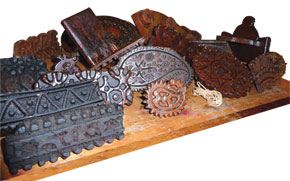
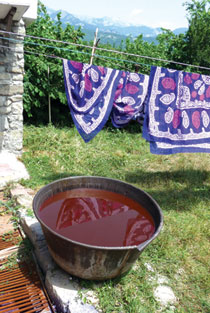
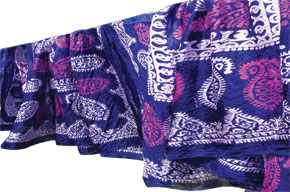

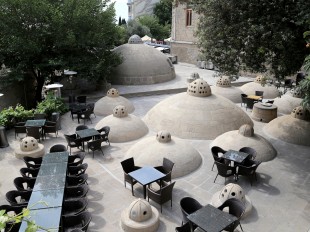
.jpg)